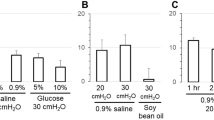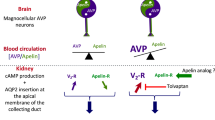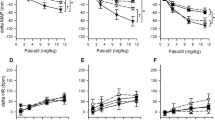Abstract
CHLOROTHIAZIDE has been in use for several years as a diuretic drug. Its diuretic effect is usually ascribed to inhibition of sodium reabsorption in tubular cells1. In recent years Chlorothiazide has been reported to decrease urine volume in diabetes insipidus2. The autidiurietc effect is accompanied, however, by saluresis, that is, increased sodium excretion3. To explain the paradoxical action of Chlorothiazide it has been suggested that the drug could also affect thirst, by decreasing plasma osmolarity through increased urinary sodium loss4,5. We have recently reported that Chlorothiazide reduced water intake in bilaterally nephrectomized rats, thus demonstrating an extra-renal effect6. Osmotic receptors related to thirst regulation have been postulated to be located in the hypothalamus7,8. Stein and Seifter have recently reported chemical excitation of thirst by deposition of acetyl-oholine crystals through a cannula into a certain area in the hypothalamus9. Applying their technique, we have deposited Chlorothiazide crystals in the same area of the hypothalamus of rats, weighing 350–400 g, using the co-ordinates of Stein and Seifter9. In control animals either calcium carbonate or talc was deposited in the same location. Food and water were given freely and daily consumption was recorded. Water intake was found decreased in rats with hypothalamic Chlorothiazide deposit compared with the control animals (Fig. 1). No difference in food consumption was noted between the two groups and the difference in water intake persisted also after withdrawal of the food. That Chlorothiazide was not absorbed to any appreciable extent into the circulation was suggested by the lower urinary volume in the Chlorothiazide rats relative to the control animals (20–26 per cent less). Furthermore, the potassium/sodium ratio in the urine was the same in the Chlorothiazide and the control groups.
This is a preview of subscription content, access via your institution
Access options
Subscribe to this journal
Receive 51 print issues and online access
$199.00 per year
only $3.90 per issue
Buy this article
- Purchase on Springer Link
- Instant access to full article PDF
Prices may be subject to local taxes which are calculated during checkout
Similar content being viewed by others
References
Beyer, K. H., and Baer, J. E., Pharmacol. Rev., 13, 517 (1961).
Crawford, J. D., and Kennedy, G. C., Nature, 183, 891 (1951).
Kennedy, G. C., and Crawford, J. D., J. Endocrinol., 22, 77 (1961).
Robson, J. S., and Lambie, A. T., Metabolism, 11, 1041 (1962).
Skadhauge, E., Acta Med. Scand., 174, 739 (1963).
Gutman, J., Experientia, 19, 544 (1963).
Verney, E. B., Proc. Roy. Soc., B, 135, 25 (1947).
Wolf, A. V., Thirst: Physiology of the Urge to Drink and Problems of Water Lack (Charles C. Thomas, Springfield, 1958).
Stein, L., and Seifter, J., Amer. J. Physiol., 202, 751 (1962).
Dicker, S. E., and Eggleton, M. G., J. Physiol. (London), 171, 377 (1964).
Kennedy, G. C., Skadhauge, E., and Hague, P., Quart. J. Exp. Physiol., 49, 417 (1964).
Díes, F., and Rivera, A., Clin. Pharmacol. Ther., 3, 172 (1962).
Author information
Authors and Affiliations
Rights and permissions
About this article
Cite this article
GUTMAN, J., CHAIMOVITZ, M. Effect of Chlorothiazide on Water Consumption in the Rat. Nature 209, 410–411 (1966). https://doi.org/10.1038/209410a0
Issue Date:
DOI: https://doi.org/10.1038/209410a0
This article is cited by
-
Effect of phenformin and chlorpropamide on renin activity in the rat
Experientia (1971)
-
The antidipsic effect of sulphonamides implanted in the hypothalamus of rats
Experientia (1968)
Comments
By submitting a comment you agree to abide by our Terms and Community Guidelines. If you find something abusive or that does not comply with our terms or guidelines please flag it as inappropriate.



